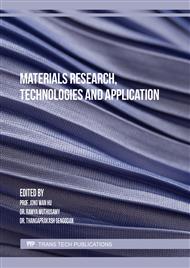[1]
Sobri, S.A., R. Heinemann, and D. Whitehead, Carbon Fibre Reinforced Polymer (CFRP) Composites: Machining Aspects and Opportunities for Manufacturing Industries, Composite Materials: Applications in Engineering, Biomedicine and Food Science. (2020) 35-65.
DOI: 10.1007/978-3-030-45489-0_2
Google Scholar
[2]
Chanpariyavatevong, A. and W. Boongsood. Tool Wear Characteristics of TiCn/Al2O3 Coated Carbide Inserts while Turning Glass Fiber Reinforced Epoxy Resin under Cryogenic Cooling, Key Engineering Materials. (2021).
DOI: 10.4028/www.scientific.net/kem.891.143
Google Scholar
[3]
Eneyew, E.D. and M. Ramulu, Experimental study of surface quality and damage when drilling unidirectional CFRP composites. Journal of Materials Research and Technology. (2014) 354-362.
DOI: 10.1016/j.jmrt.2014.10.003
Google Scholar
[4]
Wang, F., et al., Effects of cooling position on tool wear reduction of secondary cutting-edge corner of one-shot drill bit in drilling CFRP, The International Journal of Advanced Manufacturing Technology. (2018) 4277-4287.
DOI: 10.1007/s00170-017-1103-6
Google Scholar
[5]
Yang, F., Fire-retardant carbon-fiber-reinforced thermoset composites, Novel fire retardant polymers and composite materials. (2017) 271-293.
DOI: 10.1016/b978-0-08-100136-3.00010-8
Google Scholar
[6]
Uddin, M., et al., Evaluating hole quality in drilling of Al 6061 alloys, Materials. (2018) 2443.
Google Scholar
[7]
Jessy, K., D. Dinakaran, and V.S. Rao, Influence of different cooling methods on drill temperature in drilling GFRP, The International Journal of Advanced Manufacturing Technology. (2015) 609-621.
DOI: 10.1007/s00170-014-6280-y
Google Scholar
[8]
Yan, P., Y. Rong, and G. Wang, The effect of cutting fluids applied in metal cutting process, Proceedings of the Institution of Mechanical Engineers., Part B: Journal of Engineering Manufacture. (2016) 19-37.
DOI: 10.1177/0954405415590993
Google Scholar
[9]
Wang, F., et al., Secondary cutting edge wear of one-shot drill bit in drilling CFRP and its impact on hole quality, Composite Structures. (2017) 341-352.
DOI: 10.1016/j.compstruct.2017.04.024
Google Scholar
[10]
Liu, D., Y. Tang, and W. Cong, A review of mechanical drilling for composite laminates, Composite structures. (2012) 1265-1279.
DOI: 10.1016/j.compstruct.2011.11.024
Google Scholar
[11]
Sadek, A., M. Meshreki, and M. Attia, Characterization and optimization of orbital drilling of woven carbon fiber reinforced epoxy laminates, CIRP annals. (2012) 123-126.
DOI: 10.1016/j.cirp.2012.03.089
Google Scholar
[12]
Raj, D.S. and L. Karunamoorthy, Study of the effect of tool wear on hole quality in drilling CFRP to select a suitable drill for multi-criteria hole quality, Materials and Manufacturing Processes. (2016) 587-592.
DOI: 10.1080/10426914.2015.1004713
Google Scholar
[13]
Sharma, V.S., G. Singh, and K. Sørby, A review on minimum quantity lubrication for machining processes, Materials and manufacturing processes. (2015) 935-953.
DOI: 10.1080/10426914.2014.994759
Google Scholar
[14]
Nor Khairusshima, M.K., et al., Effect of chilled air on tool wear and workpiece quality during milling of carbon fibre-reinforced plastic, Wear. (2013) 1113-1123.
DOI: 10.1016/j.wear.2013.01.043
Google Scholar
[15]
Khairusshima, M.N. and I. Sharifah, Study on tool wear during milling CFRP under dry and chilled air machining, Procedia Engineering. (2017) 506-517.
DOI: 10.1016/j.proeng.2017.04.121
Google Scholar
[16]
Liew, P., U. Hashim, and M. Abd Rahman, Effect of chilled air coolant on surface roughness and tool wear when machining 2205 duplex stainless steel, Journal of Advanced Manufacturing Technology (JAMT). (2017) 61-68.
Google Scholar
[17]
Ramzi, R., E.A. Bakar, and M. Mahmod. Drill Bit Flank Wear Monitoring System in Composite Drilling Process Using Image Processing, 10th International Conference on Robotics, Vision, Signal Processing and Power Applications. (2019).
DOI: 10.1007/978-981-13-6447-1_70
Google Scholar
[18]
Celik, A., et al., Investigation on the performance of SiAlON ceramic drills on aerospace grade CFRP composites, Journal of Materials Processing Technology. (2015) 39-47.
DOI: 10.1016/j.jmatprotec.2015.03.040
Google Scholar
[19]
Khairussaleh, N.K.M., C.H.C. Haron, and J.A. Ghani, Study on wear mechanism of solid carbide cutting tool in milling CFRP, Journal of Materials Research. (2016) 1893-1899.
DOI: 10.1557/jmr.2016.21
Google Scholar



